Digital Marketing Report: Analysis of Strategies and Challenges
VerifiedAdded on 2023/02/03
|21
|5084
|59
Report
AI Summary
This report provides a comprehensive overview of digital marketing, exploring its concepts, forms, and evolution in comparison to traditional marketing methods. It delves into the application of the McKinsey 7S model to understand organizational transformation, particularly in the context of the Commercial Bank of Ceylon PLC. The report examines the advantages and challenges of digital marketing, analyzing local and international transformational change initiatives, and offering key issues and recommendations for the chosen organization. The analysis covers various aspects of digital marketing, including its impact on customer behavior, strategies for online promotion, and the role of technology in shaping marketing activities. The report also discusses the differences between digital and traditional marketing, highlighting the benefits and drawbacks of each approach. Furthermore, the report examines the application of the McKinsey 7S model in the context of the Commercial Bank of Ceylon PLC, providing a framework for understanding transformational change within the organization. In addition, the report presents a comparison between the McKinsey 7S model and the transformational change model for the Commercial Bank of Ceylon PLC. The report concludes with a summary of the key findings and recommendations, providing valuable insights for organizations seeking to leverage digital marketing strategies.
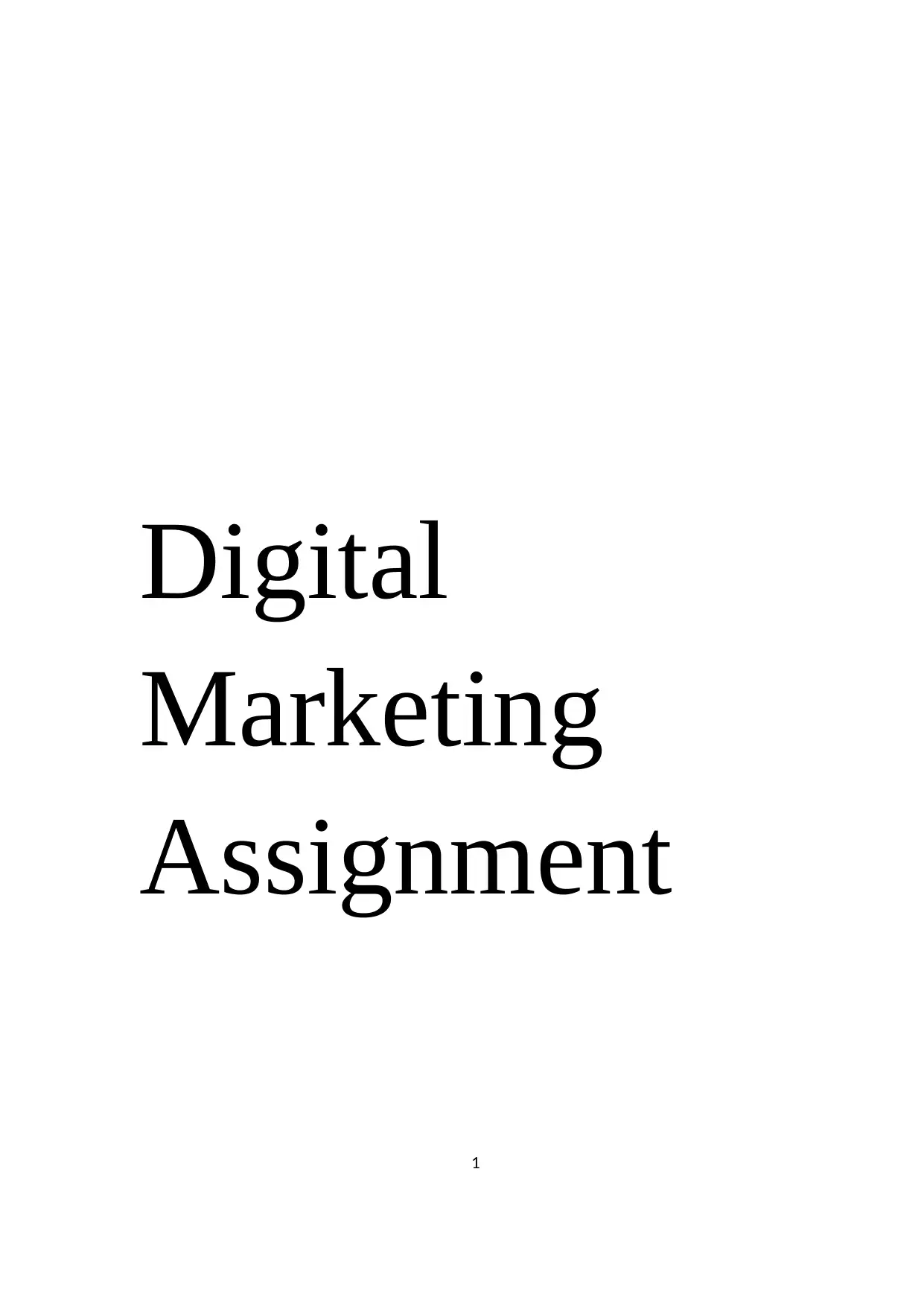
1
Digital
Marketing
Assignment
Digital
Marketing
Assignment
Paraphrase This Document
Need a fresh take? Get an instant paraphrase of this document with our AI Paraphraser
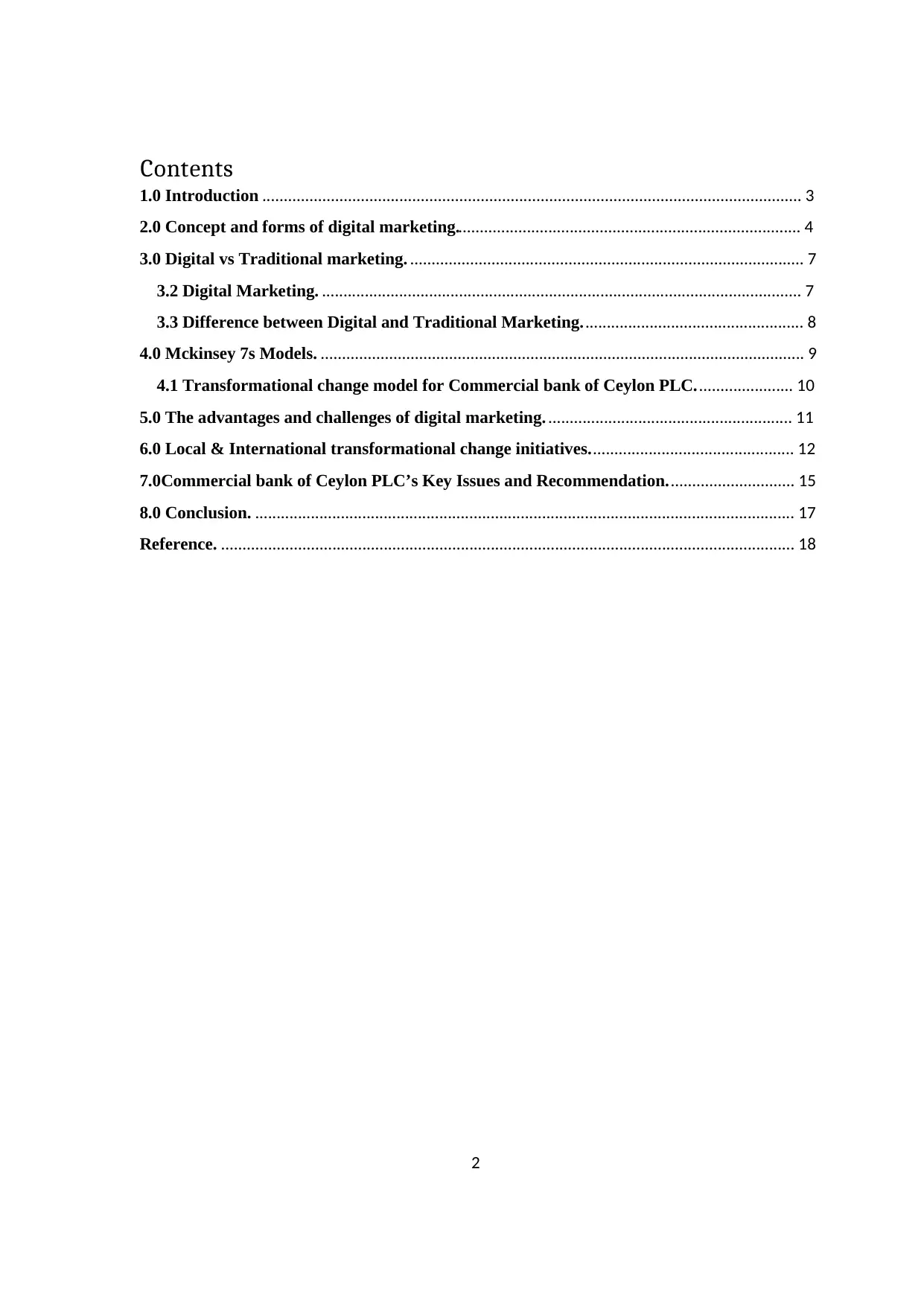
2
Contents
1.0 Introduction .............................................................................................................................. 3
2.0 Concept and forms of digital marketing................................................................................. 4
3.0 Digital vs Traditional marketing. ............................................................................................ 7
3.2 Digital Marketing. ................................................................................................................ 7
3.3 Difference between Digital and Traditional Marketing. ................................................... 8
4.0 Mckinsey 7s Models. ................................................................................................................. 9
4.1 Transformational change model for Commercial bank of Ceylon PLC. ...................... 10
5.0 The advantages and challenges of digital marketing. ......................................................... 11
6.0 Local & International transformational change initiatives. ............................................... 12
7.0Commercial bank of Ceylon PLC’s Key Issues and Recommendation. ............................. 15
8.0 Conclusion. .............................................................................................................................. 17
Reference. ...................................................................................................................................... 18
Contents
1.0 Introduction .............................................................................................................................. 3
2.0 Concept and forms of digital marketing................................................................................. 4
3.0 Digital vs Traditional marketing. ............................................................................................ 7
3.2 Digital Marketing. ................................................................................................................ 7
3.3 Difference between Digital and Traditional Marketing. ................................................... 8
4.0 Mckinsey 7s Models. ................................................................................................................. 9
4.1 Transformational change model for Commercial bank of Ceylon PLC. ...................... 10
5.0 The advantages and challenges of digital marketing. ......................................................... 11
6.0 Local & International transformational change initiatives. ............................................... 12
7.0Commercial bank of Ceylon PLC’s Key Issues and Recommendation. ............................. 15
8.0 Conclusion. .............................................................................................................................. 17
Reference. ...................................................................................................................................... 18
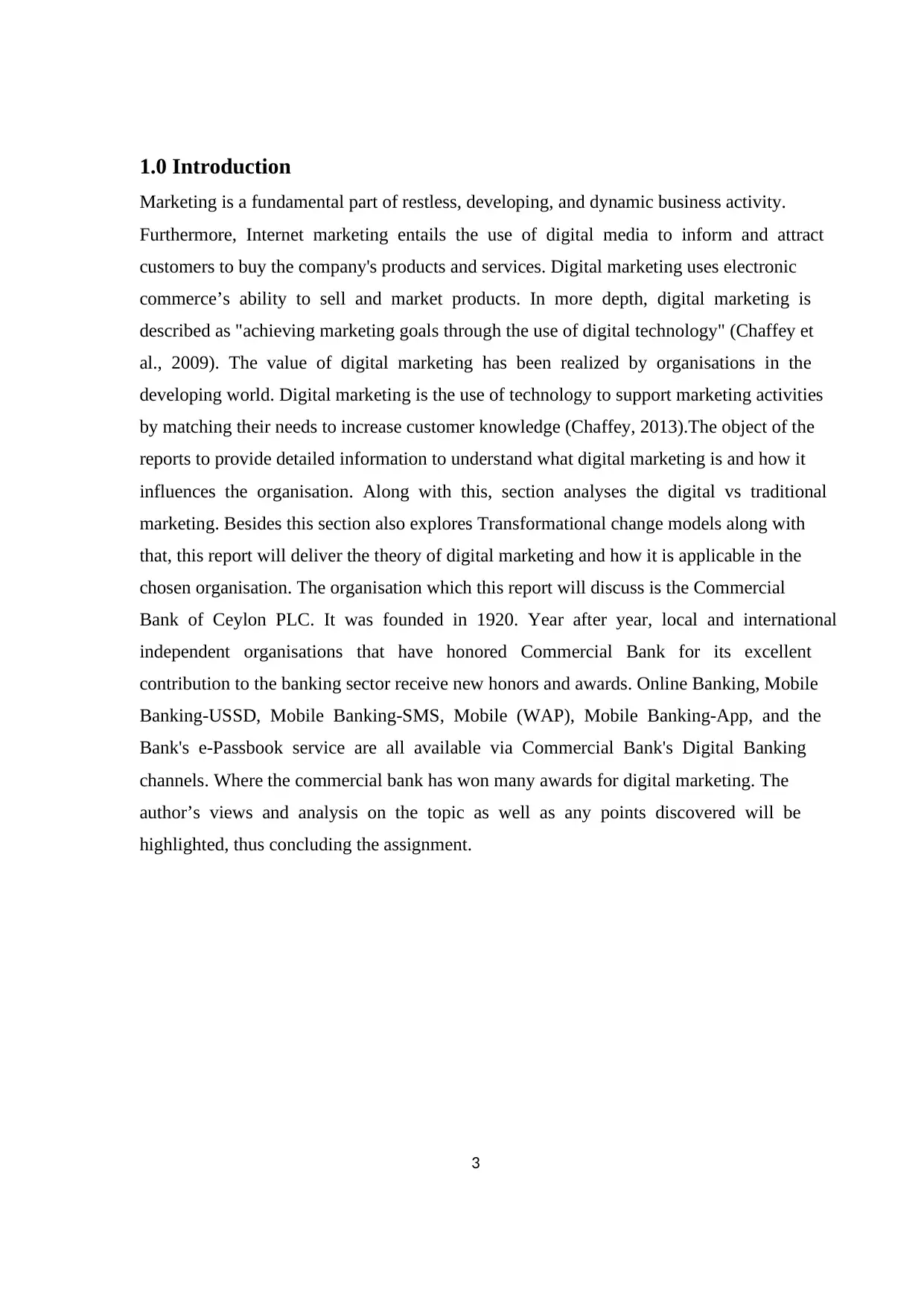
3
1.0 Introduction
Marketing is a fundamental part of restless, developing, and dynamic business activity.
Furthermore, Internet marketing entails the use of digital media to inform and attract
customers to buy the company's products and services. Digital marketing uses electronic
commerce’s ability to sell and market products. In more depth, digital marketing is
described as "achieving marketing goals through the use of digital technology" (Chaffey et
al., 2009). The value of digital marketing has been realized by organisations in the
developing world. Digital marketing is the use of technology to support marketing activities
by matching their needs to increase customer knowledge (Chaffey, 2013).The object of the
reports to provide detailed information to understand what digital marketing is and how it
influences the organisation. Along with this, section analyses the digital vs traditional
marketing. Besides this section also explores Transformational change models along with
that, this report will deliver the theory of digital marketing and how it is applicable in the
chosen organisation. The organisation which this report will discuss is the Commercial
Bank of Ceylon PLC. It was founded in 1920. Year after year, local and international
independent organisations that have honored Commercial Bank for its excellent
contribution to the banking sector receive new honors and awards. Online Banking, Mobile
Banking-USSD, Mobile Banking-SMS, Mobile (WAP), Mobile Banking-App, and the
Bank's e-Passbook service are all available via Commercial Bank's Digital Banking
channels. Where the commercial bank has won many awards for digital marketing. The
author’s views and analysis on the topic as well as any points discovered will be
highlighted, thus concluding the assignment.
1.0 Introduction
Marketing is a fundamental part of restless, developing, and dynamic business activity.
Furthermore, Internet marketing entails the use of digital media to inform and attract
customers to buy the company's products and services. Digital marketing uses electronic
commerce’s ability to sell and market products. In more depth, digital marketing is
described as "achieving marketing goals through the use of digital technology" (Chaffey et
al., 2009). The value of digital marketing has been realized by organisations in the
developing world. Digital marketing is the use of technology to support marketing activities
by matching their needs to increase customer knowledge (Chaffey, 2013).The object of the
reports to provide detailed information to understand what digital marketing is and how it
influences the organisation. Along with this, section analyses the digital vs traditional
marketing. Besides this section also explores Transformational change models along with
that, this report will deliver the theory of digital marketing and how it is applicable in the
chosen organisation. The organisation which this report will discuss is the Commercial
Bank of Ceylon PLC. It was founded in 1920. Year after year, local and international
independent organisations that have honored Commercial Bank for its excellent
contribution to the banking sector receive new honors and awards. Online Banking, Mobile
Banking-USSD, Mobile Banking-SMS, Mobile (WAP), Mobile Banking-App, and the
Bank's e-Passbook service are all available via Commercial Bank's Digital Banking
channels. Where the commercial bank has won many awards for digital marketing. The
author’s views and analysis on the topic as well as any points discovered will be
highlighted, thus concluding the assignment.
⊘ This is a preview!⊘
Do you want full access?
Subscribe today to unlock all pages.

Trusted by 1+ million students worldwide
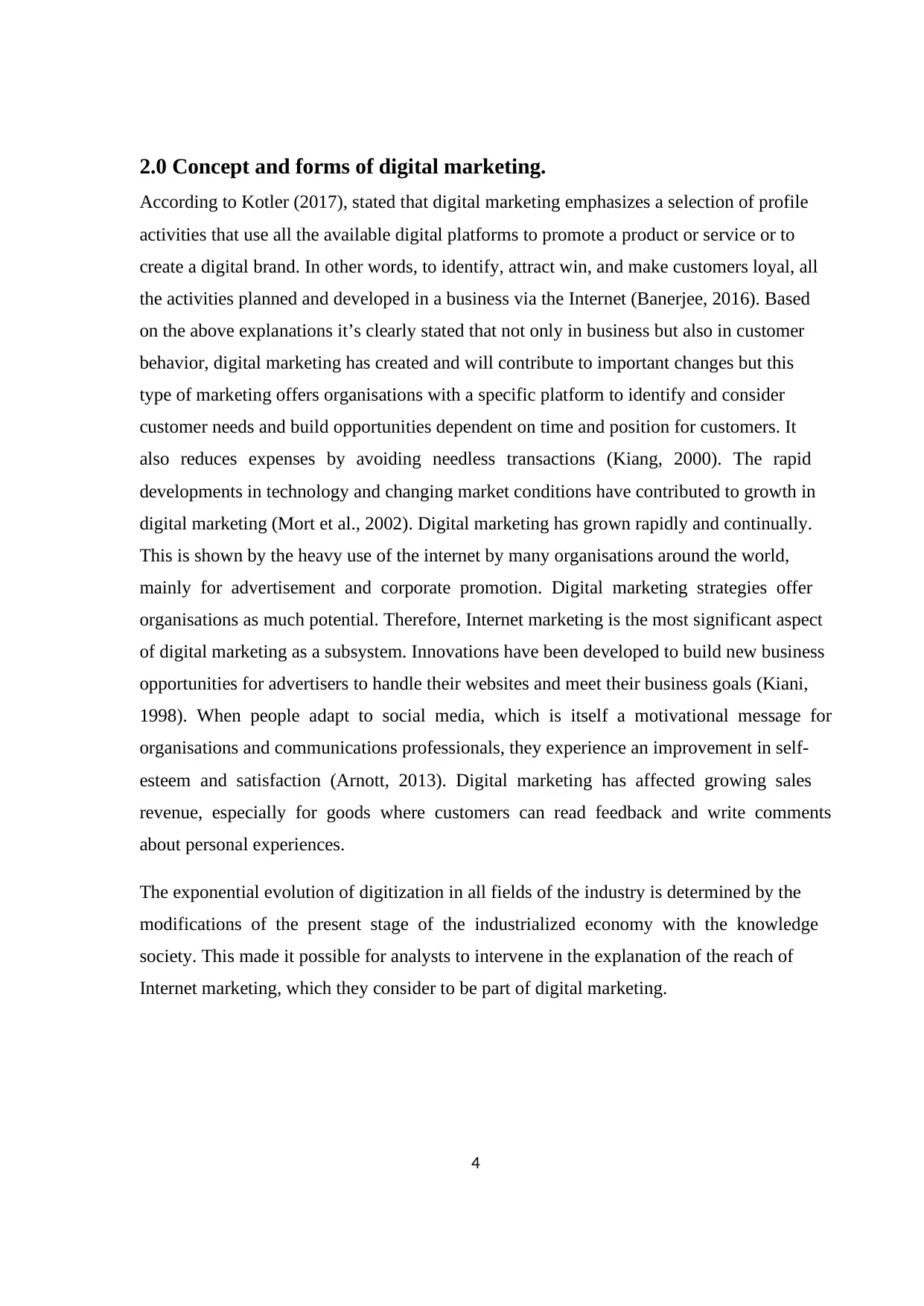
4
2.0 Concept and forms of digital marketing.
According to Kotler (2017), stated that digital marketing emphasizes a selection of profile
activities that use all the available digital platforms to promote a product or service or to
create a digital brand. In other words, to identify, attract win, and make customers loyal, all
the activities planned and developed in a business via the Internet (Banerjee, 2016). Based
on the above explanations it’s clearly stated that not only in business but also in customer
behavior, digital marketing has created and will contribute to important changes but this
type of marketing offers organisations with a specific platform to identify and consider
customer needs and build opportunities dependent on time and position for customers. It
also reduces expenses by avoiding needless transactions (Kiang, 2000). The rapid
developments in technology and changing market conditions have contributed to growth in
digital marketing (Mort et al., 2002). Digital marketing has grown rapidly and continually.
This is shown by the heavy use of the internet by many organisations around the world,
mainly for advertisement and corporate promotion. Digital marketing strategies offer
organisations as much potential. Therefore, Internet marketing is the most significant aspect
of digital marketing as a subsystem. Innovations have been developed to build new business
opportunities for advertisers to handle their websites and meet their business goals (Kiani,
1998). When people adapt to social media, which is itself a motivational message for
organisations and communications professionals, they experience an improvement in self-
esteem and satisfaction (Arnott, 2013). Digital marketing has affected growing sales
revenue, especially for goods where customers can read feedback and write comments
about personal experiences.
The exponential evolution of digitization in all fields of the industry is determined by the
modifications of the present stage of the industrialized economy with the knowledge
society. This made it possible for analysts to intervene in the explanation of the reach of
Internet marketing, which they consider to be part of digital marketing.
2.0 Concept and forms of digital marketing.
According to Kotler (2017), stated that digital marketing emphasizes a selection of profile
activities that use all the available digital platforms to promote a product or service or to
create a digital brand. In other words, to identify, attract win, and make customers loyal, all
the activities planned and developed in a business via the Internet (Banerjee, 2016). Based
on the above explanations it’s clearly stated that not only in business but also in customer
behavior, digital marketing has created and will contribute to important changes but this
type of marketing offers organisations with a specific platform to identify and consider
customer needs and build opportunities dependent on time and position for customers. It
also reduces expenses by avoiding needless transactions (Kiang, 2000). The rapid
developments in technology and changing market conditions have contributed to growth in
digital marketing (Mort et al., 2002). Digital marketing has grown rapidly and continually.
This is shown by the heavy use of the internet by many organisations around the world,
mainly for advertisement and corporate promotion. Digital marketing strategies offer
organisations as much potential. Therefore, Internet marketing is the most significant aspect
of digital marketing as a subsystem. Innovations have been developed to build new business
opportunities for advertisers to handle their websites and meet their business goals (Kiani,
1998). When people adapt to social media, which is itself a motivational message for
organisations and communications professionals, they experience an improvement in self-
esteem and satisfaction (Arnott, 2013). Digital marketing has affected growing sales
revenue, especially for goods where customers can read feedback and write comments
about personal experiences.
The exponential evolution of digitization in all fields of the industry is determined by the
modifications of the present stage of the industrialized economy with the knowledge
society. This made it possible for analysts to intervene in the explanation of the reach of
Internet marketing, which they consider to be part of digital marketing.
Paraphrase This Document
Need a fresh take? Get an instant paraphrase of this document with our AI Paraphraser
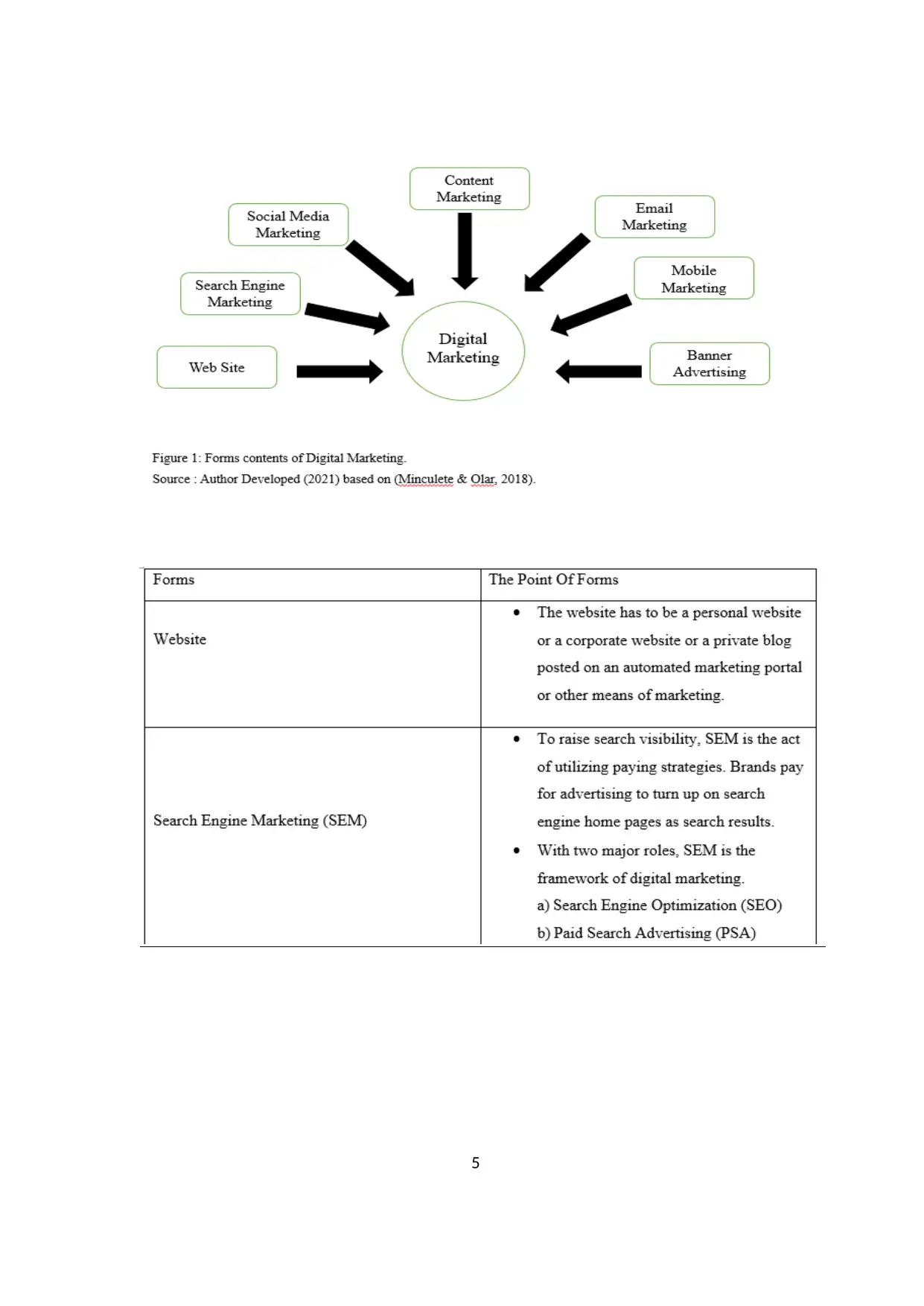
5
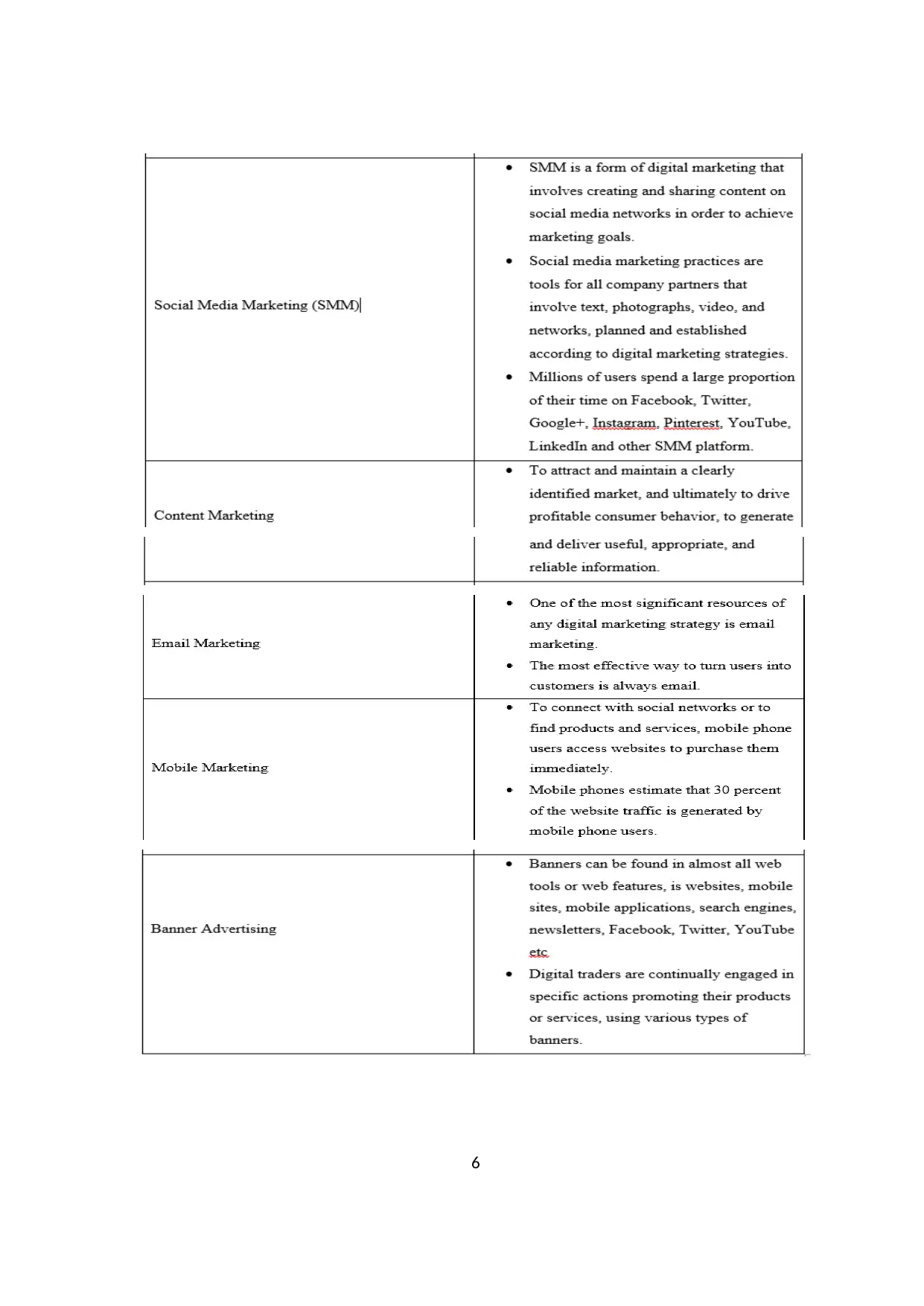
6
⊘ This is a preview!⊘
Do you want full access?
Subscribe today to unlock all pages.

Trusted by 1+ million students worldwide
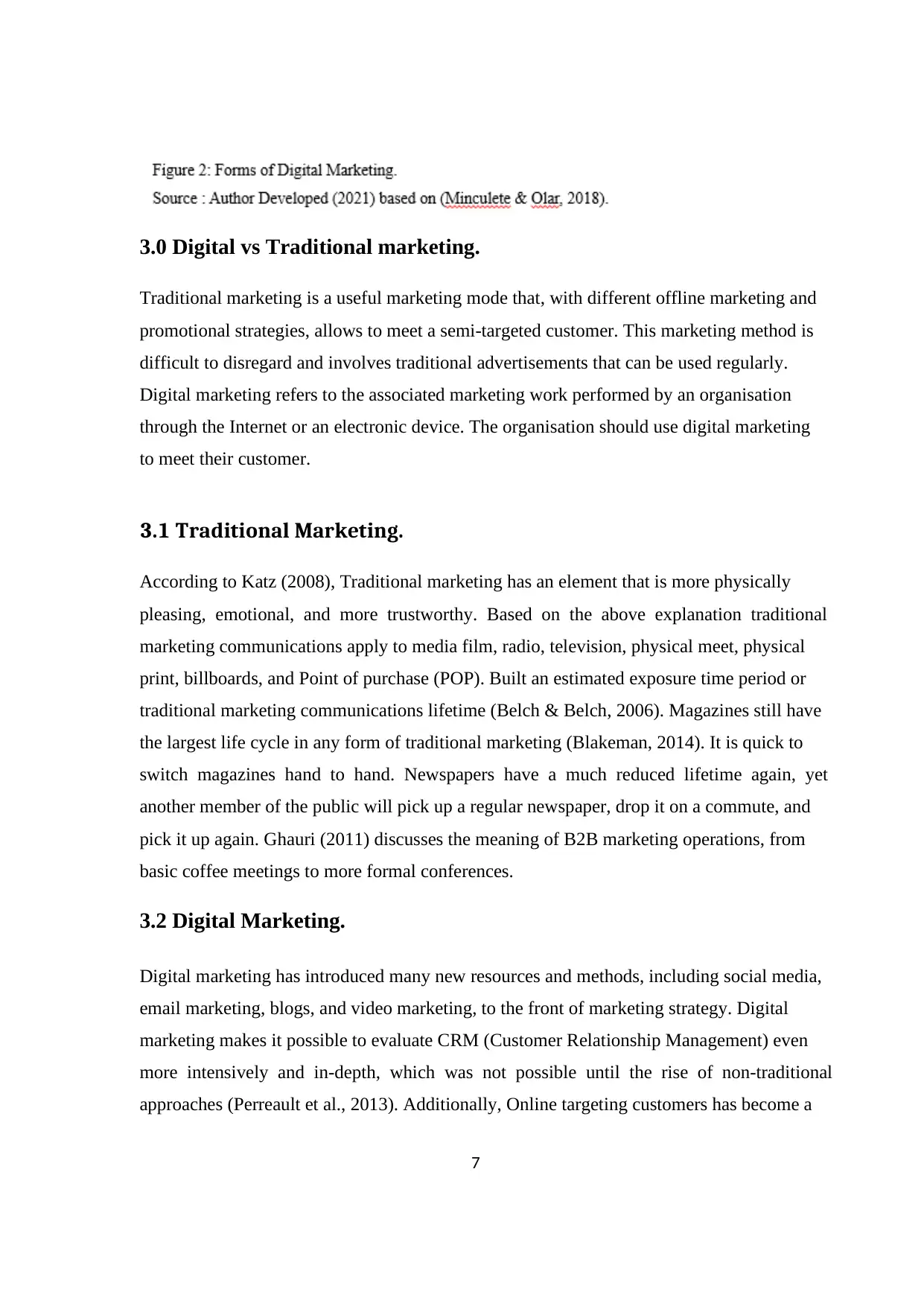
7
3.0 Digital vs Traditional marketing.
Traditional marketing is a useful marketing mode that, with different offline marketing and
promotional strategies, allows to meet a semi-targeted customer. This marketing method is
difficult to disregard and involves traditional advertisements that can be used regularly.
Digital marketing refers to the associated marketing work performed by an organisation
through the Internet or an electronic device. The organisation should use digital marketing
to meet their customer.
3.1 Traditional Marketing.
According to Katz (2008), Traditional marketing has an element that is more physically
pleasing, emotional, and more trustworthy. Based on the above explanation traditional
marketing communications apply to media film, radio, television, physical meet, physical
print, billboards, and Point of purchase (POP). Built an estimated exposure time period or
traditional marketing communications lifetime (Belch & Belch, 2006). Magazines still have
the largest life cycle in any form of traditional marketing (Blakeman, 2014). It is quick to
switch magazines hand to hand. Newspapers have a much reduced lifetime again, yet
another member of the public will pick up a regular newspaper, drop it on a commute, and
pick it up again. Ghauri (2011) discusses the meaning of B2B marketing operations, from
basic coffee meetings to more formal conferences.
3.2 Digital Marketing.
Digital marketing has introduced many new resources and methods, including social media,
email marketing, blogs, and video marketing, to the front of marketing strategy. Digital
marketing makes it possible to evaluate CRM (Customer Relationship Management) even
more intensively and in-depth, which was not possible until the rise of non-traditional
approaches (Perreault et al., 2013). Additionally, Online targeting customers has become a
3.0 Digital vs Traditional marketing.
Traditional marketing is a useful marketing mode that, with different offline marketing and
promotional strategies, allows to meet a semi-targeted customer. This marketing method is
difficult to disregard and involves traditional advertisements that can be used regularly.
Digital marketing refers to the associated marketing work performed by an organisation
through the Internet or an electronic device. The organisation should use digital marketing
to meet their customer.
3.1 Traditional Marketing.
According to Katz (2008), Traditional marketing has an element that is more physically
pleasing, emotional, and more trustworthy. Based on the above explanation traditional
marketing communications apply to media film, radio, television, physical meet, physical
print, billboards, and Point of purchase (POP). Built an estimated exposure time period or
traditional marketing communications lifetime (Belch & Belch, 2006). Magazines still have
the largest life cycle in any form of traditional marketing (Blakeman, 2014). It is quick to
switch magazines hand to hand. Newspapers have a much reduced lifetime again, yet
another member of the public will pick up a regular newspaper, drop it on a commute, and
pick it up again. Ghauri (2011) discusses the meaning of B2B marketing operations, from
basic coffee meetings to more formal conferences.
3.2 Digital Marketing.
Digital marketing has introduced many new resources and methods, including social media,
email marketing, blogs, and video marketing, to the front of marketing strategy. Digital
marketing makes it possible to evaluate CRM (Customer Relationship Management) even
more intensively and in-depth, which was not possible until the rise of non-traditional
approaches (Perreault et al., 2013). Additionally, Online targeting customers has become a
Paraphrase This Document
Need a fresh take? Get an instant paraphrase of this document with our AI Paraphraser
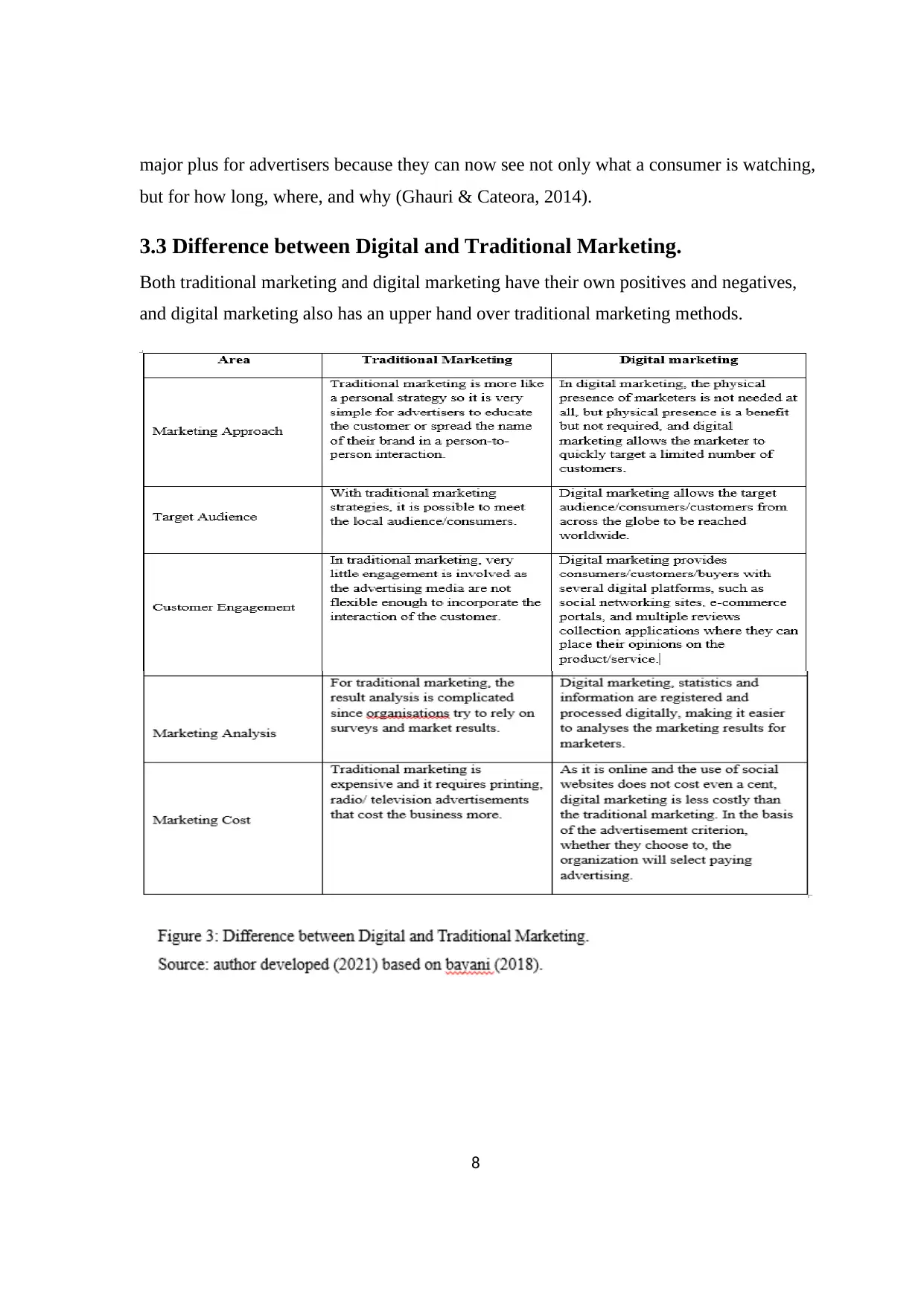
8
major plus for advertisers because they can now see not only what a consumer is watching,
but for how long, where, and why (Ghauri & Cateora, 2014).
3.3 Difference between Digital and Traditional Marketing.
Both traditional marketing and digital marketing have their own positives and negatives,
and digital marketing also has an upper hand over traditional marketing methods.
major plus for advertisers because they can now see not only what a consumer is watching,
but for how long, where, and why (Ghauri & Cateora, 2014).
3.3 Difference between Digital and Traditional Marketing.
Both traditional marketing and digital marketing have their own positives and negatives,
and digital marketing also has an upper hand over traditional marketing methods.
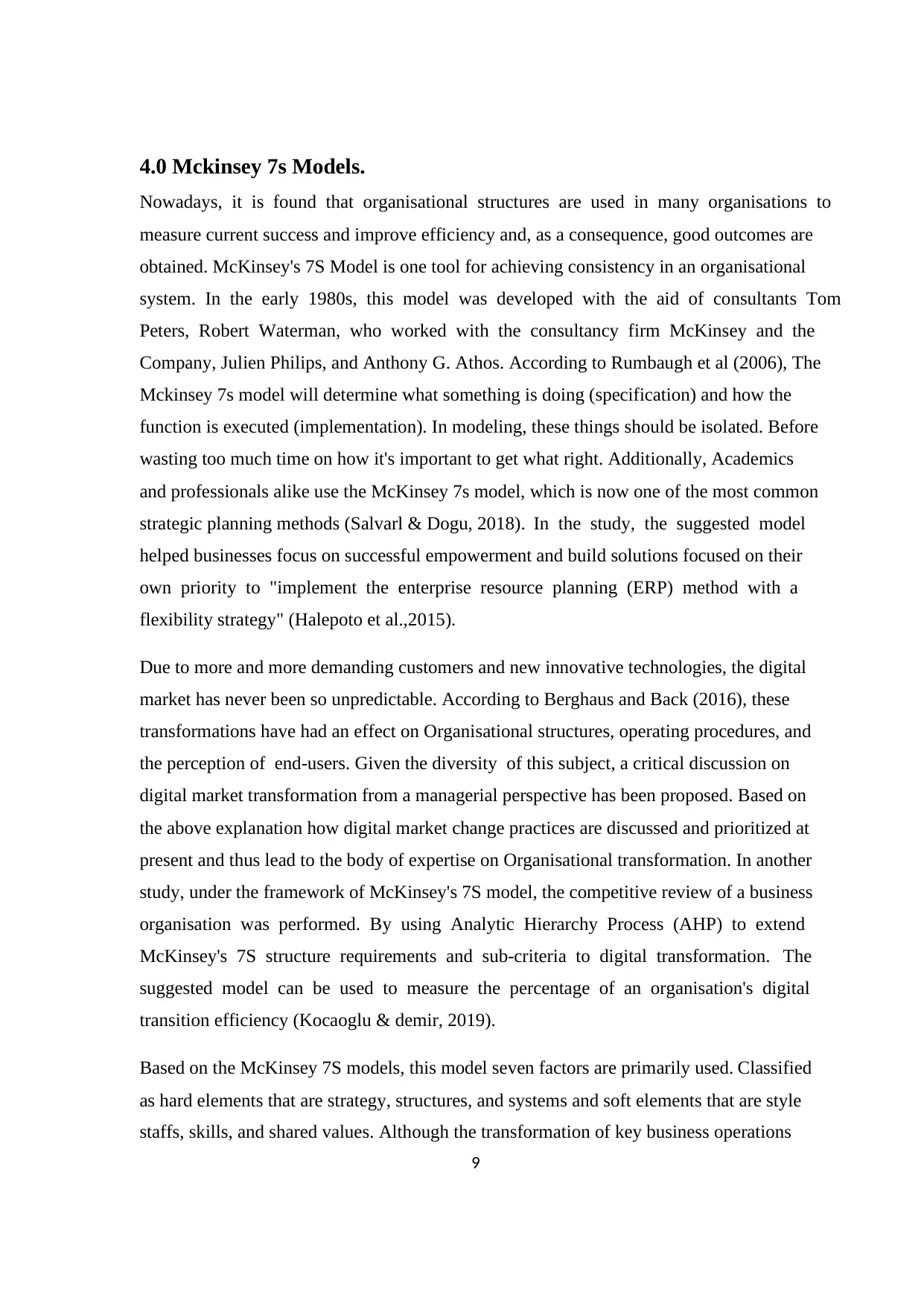
9
4.0 Mckinsey 7s Models.
Nowadays, it is found that organisational structures are used in many organisations to
measure current success and improve efficiency and, as a consequence, good outcomes are
obtained. McKinsey's 7S Model is one tool for achieving consistency in an organisational
system. In the early 1980s, this model was developed with the aid of consultants Tom
Peters, Robert Waterman, who worked with the consultancy firm McKinsey and the
Company, Julien Philips, and Anthony G. Athos. According to Rumbaugh et al (2006), The
Mckinsey 7s model will determine what something is doing (specification) and how the
function is executed (implementation). In modeling, these things should be isolated. Before
wasting too much time on how it's important to get what right. Additionally, Academics
and professionals alike use the McKinsey 7s model, which is now one of the most common
strategic planning methods (Salvarl & Dogu, 2018). In the study, the suggested model
helped businesses focus on successful empowerment and build solutions focused on their
own priority to "implement the enterprise resource planning (ERP) method with a
flexibility strategy" (Halepoto et al.,2015).
Due to more and more demanding customers and new innovative technologies, the digital
market has never been so unpredictable. According to Berghaus and Back (2016), these
transformations have had an effect on Organisational structures, operating procedures, and
the perception of end-users. Given the diversity of this subject, a critical discussion on
digital market transformation from a managerial perspective has been proposed. Based on
the above explanation how digital market change practices are discussed and prioritized at
present and thus lead to the body of expertise on Organisational transformation. In another
study, under the framework of McKinsey's 7S model, the competitive review of a business
organisation was performed. By using Analytic Hierarchy Process (AHP) to extend
McKinsey's 7S structure requirements and sub-criteria to digital transformation. The
suggested model can be used to measure the percentage of an organisation's digital
transition efficiency (Kocaoglu & demir, 2019).
Based on the McKinsey 7S models, this model seven factors are primarily used. Classified
as hard elements that are strategy, structures, and systems and soft elements that are style
staffs, skills, and shared values. Although the transformation of key business operations
4.0 Mckinsey 7s Models.
Nowadays, it is found that organisational structures are used in many organisations to
measure current success and improve efficiency and, as a consequence, good outcomes are
obtained. McKinsey's 7S Model is one tool for achieving consistency in an organisational
system. In the early 1980s, this model was developed with the aid of consultants Tom
Peters, Robert Waterman, who worked with the consultancy firm McKinsey and the
Company, Julien Philips, and Anthony G. Athos. According to Rumbaugh et al (2006), The
Mckinsey 7s model will determine what something is doing (specification) and how the
function is executed (implementation). In modeling, these things should be isolated. Before
wasting too much time on how it's important to get what right. Additionally, Academics
and professionals alike use the McKinsey 7s model, which is now one of the most common
strategic planning methods (Salvarl & Dogu, 2018). In the study, the suggested model
helped businesses focus on successful empowerment and build solutions focused on their
own priority to "implement the enterprise resource planning (ERP) method with a
flexibility strategy" (Halepoto et al.,2015).
Due to more and more demanding customers and new innovative technologies, the digital
market has never been so unpredictable. According to Berghaus and Back (2016), these
transformations have had an effect on Organisational structures, operating procedures, and
the perception of end-users. Given the diversity of this subject, a critical discussion on
digital market transformation from a managerial perspective has been proposed. Based on
the above explanation how digital market change practices are discussed and prioritized at
present and thus lead to the body of expertise on Organisational transformation. In another
study, under the framework of McKinsey's 7S model, the competitive review of a business
organisation was performed. By using Analytic Hierarchy Process (AHP) to extend
McKinsey's 7S structure requirements and sub-criteria to digital transformation. The
suggested model can be used to measure the percentage of an organisation's digital
transition efficiency (Kocaoglu & demir, 2019).
Based on the McKinsey 7S models, this model seven factors are primarily used. Classified
as hard elements that are strategy, structures, and systems and soft elements that are style
staffs, skills, and shared values. Although the transformation of key business operations
⊘ This is a preview!⊘
Do you want full access?
Subscribe today to unlock all pages.

Trusted by 1+ million students worldwide
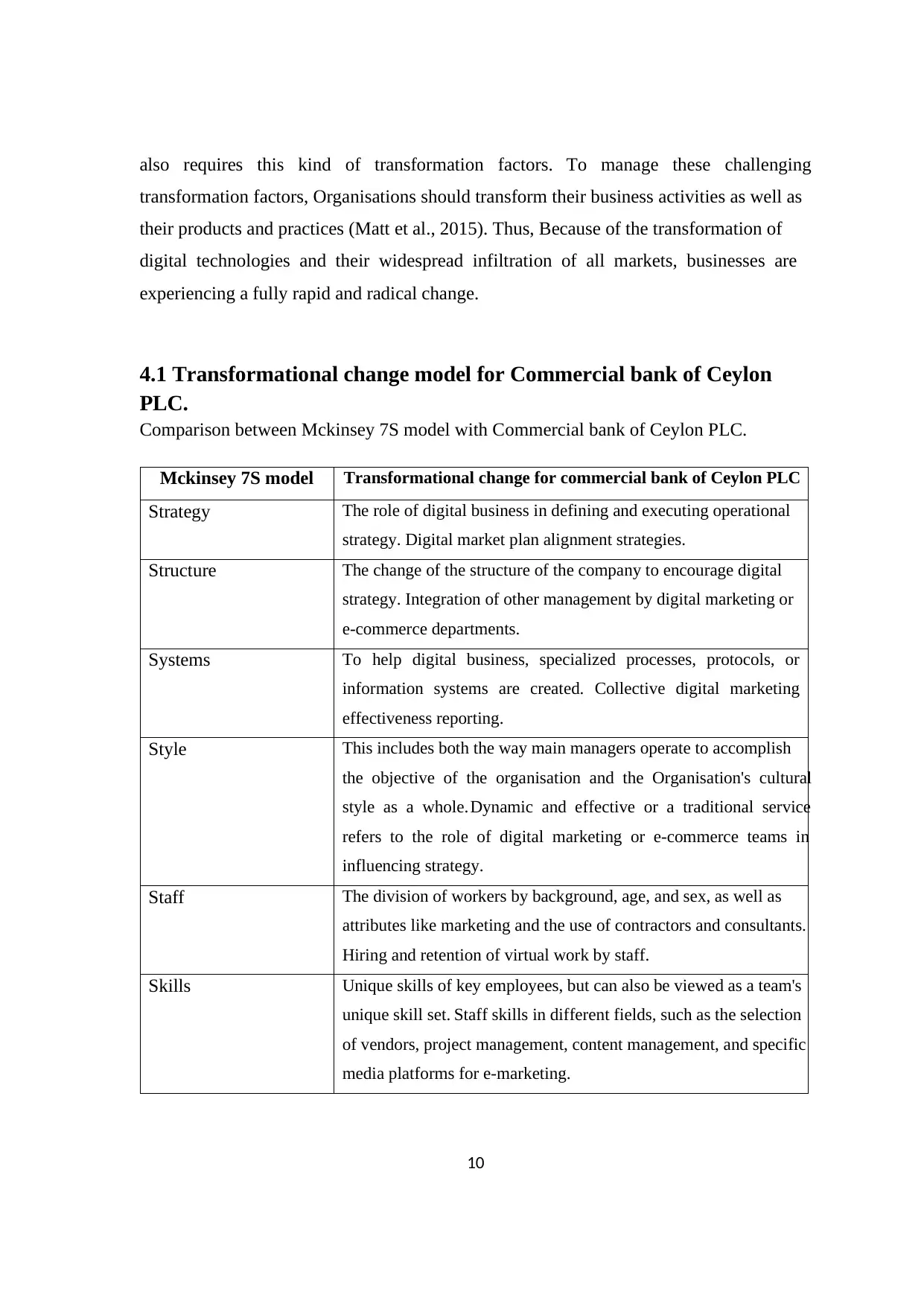
10
also requires this kind of transformation factors. To manage these challenging
transformation factors, Organisations should transform their business activities as well as
their products and practices (Matt et al., 2015). Thus, Because of the transformation of
digital technologies and their widespread infiltration of all markets, businesses are
experiencing a fully rapid and radical change.
4.1 Transformational change model for Commercial bank of Ceylon
PLC.
Comparison between Mckinsey 7S model with Commercial bank of Ceylon PLC.
Mckinsey 7S model Transformational change for commercial bank of Ceylon PLC
Strategy The role of digital business in defining and executing operational
strategy. Digital market plan alignment strategies.
Structure The change of the structure of the company to encourage digital
strategy. Integration of other management by digital marketing or
e-commerce departments.
Systems To help digital business, specialized processes, protocols, or
information systems are created. Collective digital marketing
effectiveness reporting.
Style This includes both the way main managers operate to accomplish
the objective of the organisation and the Organisation's cultural
style as a whole. Dynamic and effective or a traditional service
refers to the role of digital marketing or e-commerce teams in
influencing strategy.
Staff The division of workers by background, age, and sex, as well as
attributes like marketing and the use of contractors and consultants.
Hiring and retention of virtual work by staff.
Skills Unique skills of key employees, but can also be viewed as a team's
unique skill set. Staff skills in different fields, such as the selection
of vendors, project management, content management, and specific
media platforms for e-marketing.
also requires this kind of transformation factors. To manage these challenging
transformation factors, Organisations should transform their business activities as well as
their products and practices (Matt et al., 2015). Thus, Because of the transformation of
digital technologies and their widespread infiltration of all markets, businesses are
experiencing a fully rapid and radical change.
4.1 Transformational change model for Commercial bank of Ceylon
PLC.
Comparison between Mckinsey 7S model with Commercial bank of Ceylon PLC.
Mckinsey 7S model Transformational change for commercial bank of Ceylon PLC
Strategy The role of digital business in defining and executing operational
strategy. Digital market plan alignment strategies.
Structure The change of the structure of the company to encourage digital
strategy. Integration of other management by digital marketing or
e-commerce departments.
Systems To help digital business, specialized processes, protocols, or
information systems are created. Collective digital marketing
effectiveness reporting.
Style This includes both the way main managers operate to accomplish
the objective of the organisation and the Organisation's cultural
style as a whole. Dynamic and effective or a traditional service
refers to the role of digital marketing or e-commerce teams in
influencing strategy.
Staff The division of workers by background, age, and sex, as well as
attributes like marketing and the use of contractors and consultants.
Hiring and retention of virtual work by staff.
Skills Unique skills of key employees, but can also be viewed as a team's
unique skill set. Staff skills in different fields, such as the selection
of vendors, project management, content management, and specific
media platforms for e-marketing.
Paraphrase This Document
Need a fresh take? Get an instant paraphrase of this document with our AI Paraphraser
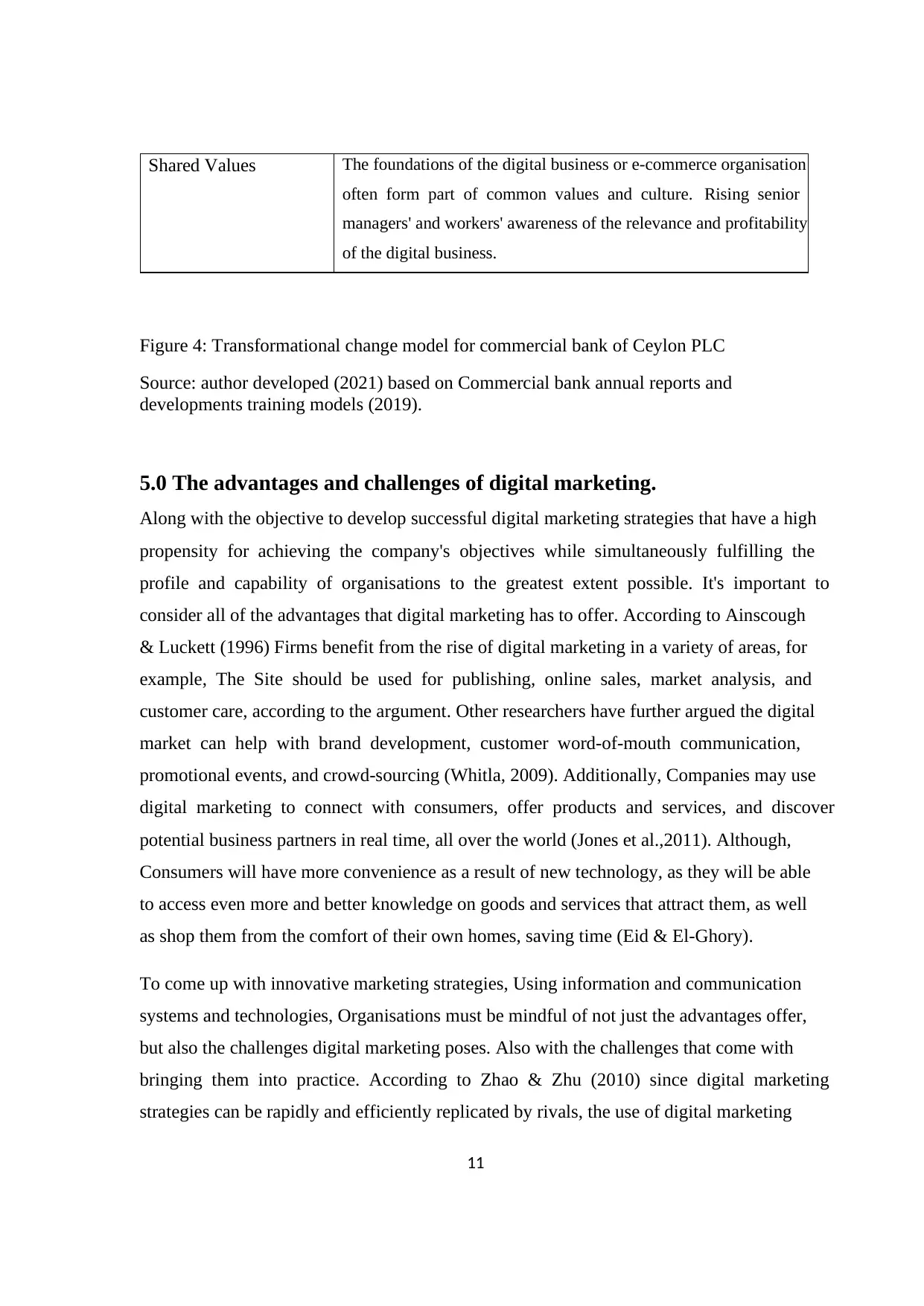
11
Shared Values The foundations of the digital business or e-commerce organisation
often form part of common values and culture. Rising senior
managers' and workers' awareness of the relevance and profitability
of the digital business.
Figure 4: Transformational change model for commercial bank of Ceylon PLC
Source: author developed (2021) based on Commercial bank annual reports and
developments training models (2019).
5.0 The advantages and challenges of digital marketing.
Along with the objective to develop successful digital marketing strategies that have a high
propensity for achieving the company's objectives while simultaneously fulfilling the
profile and capability of organisations to the greatest extent possible. It's important to
consider all of the advantages that digital marketing has to offer. According to Ainscough
& Luckett (1996) Firms benefit from the rise of digital marketing in a variety of areas, for
example, The Site should be used for publishing, online sales, market analysis, and
customer care, according to the argument. Other researchers have further argued the digital
market can help with brand development, customer word-of-mouth communication,
promotional events, and crowd-sourcing (Whitla, 2009). Additionally, Companies may use
digital marketing to connect with consumers, offer products and services, and discover
potential business partners in real time, all over the world (Jones et al.,2011). Although,
Consumers will have more convenience as a result of new technology, as they will be able
to access even more and better knowledge on goods and services that attract them, as well
as shop them from the comfort of their own homes, saving time (Eid & El-Ghory).
To come up with innovative marketing strategies, Using information and communication
systems and technologies, Organisations must be mindful of not just the advantages offer,
but also the challenges digital marketing poses. Also with the challenges that come with
bringing them into practice. According to Zhao & Zhu (2010) since digital marketing
strategies can be rapidly and efficiently replicated by rivals, the use of digital marketing
Shared Values The foundations of the digital business or e-commerce organisation
often form part of common values and culture. Rising senior
managers' and workers' awareness of the relevance and profitability
of the digital business.
Figure 4: Transformational change model for commercial bank of Ceylon PLC
Source: author developed (2021) based on Commercial bank annual reports and
developments training models (2019).
5.0 The advantages and challenges of digital marketing.
Along with the objective to develop successful digital marketing strategies that have a high
propensity for achieving the company's objectives while simultaneously fulfilling the
profile and capability of organisations to the greatest extent possible. It's important to
consider all of the advantages that digital marketing has to offer. According to Ainscough
& Luckett (1996) Firms benefit from the rise of digital marketing in a variety of areas, for
example, The Site should be used for publishing, online sales, market analysis, and
customer care, according to the argument. Other researchers have further argued the digital
market can help with brand development, customer word-of-mouth communication,
promotional events, and crowd-sourcing (Whitla, 2009). Additionally, Companies may use
digital marketing to connect with consumers, offer products and services, and discover
potential business partners in real time, all over the world (Jones et al.,2011). Although,
Consumers will have more convenience as a result of new technology, as they will be able
to access even more and better knowledge on goods and services that attract them, as well
as shop them from the comfort of their own homes, saving time (Eid & El-Ghory).
To come up with innovative marketing strategies, Using information and communication
systems and technologies, Organisations must be mindful of not just the advantages offer,
but also the challenges digital marketing poses. Also with the challenges that come with
bringing them into practice. According to Zhao & Zhu (2010) since digital marketing
strategies can be rapidly and efficiently replicated by rivals, the use of digital marketing
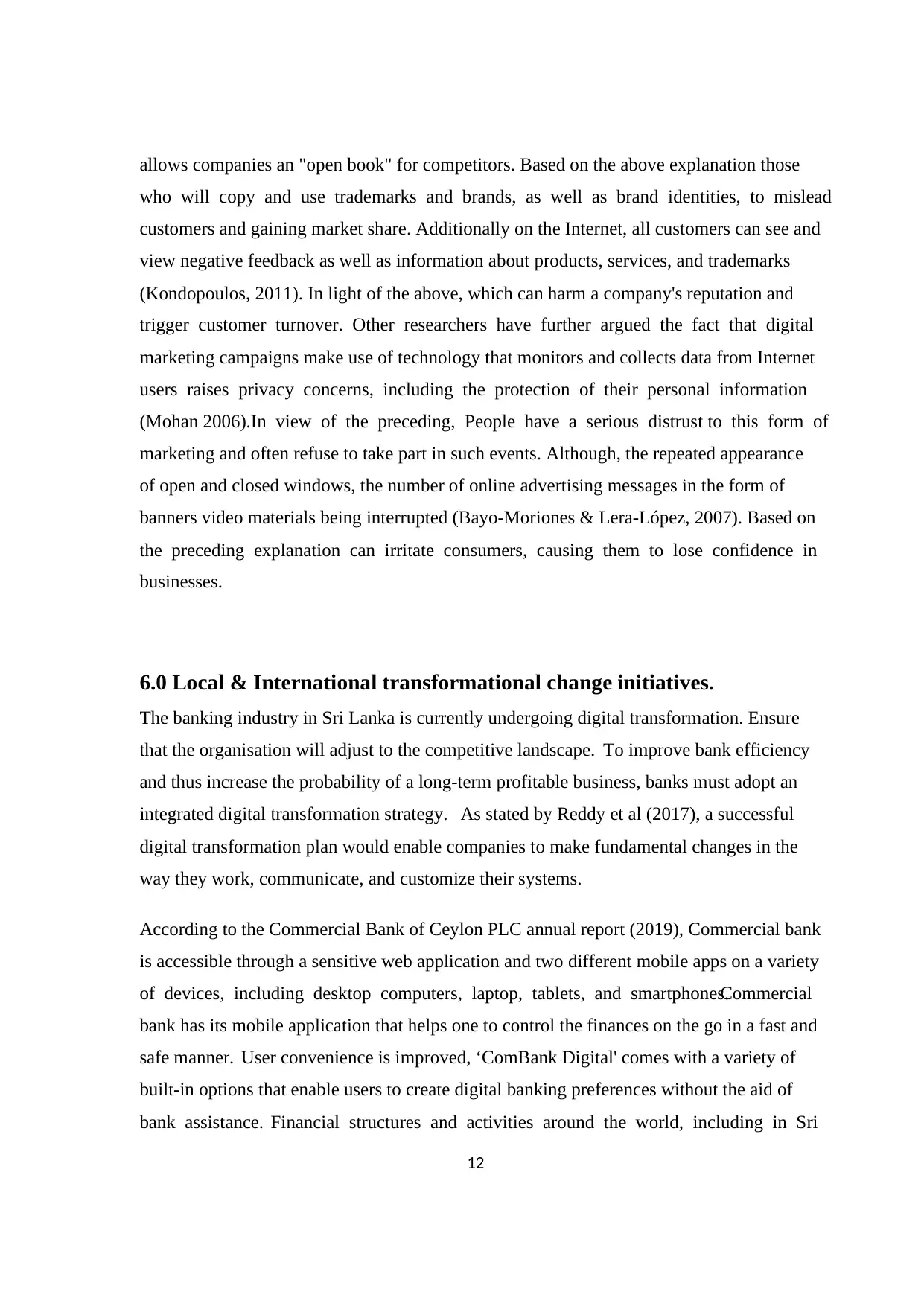
12
allows companies an "open book" for competitors. Based on the above explanation those
who will copy and use trademarks and brands, as well as brand identities, to mislead
customers and gaining market share. Additionally on the Internet, all customers can see and
view negative feedback as well as information about products, services, and trademarks
(Kondopoulos, 2011). In light of the above, which can harm a company's reputation and
trigger customer turnover. Other researchers have further argued the fact that digital
marketing campaigns make use of technology that monitors and collects data from Internet
users raises privacy concerns, including the protection of their personal information
(Mohan 2006).In view of the preceding, People have a serious distrust to this form of
marketing and often refuse to take part in such events. Although, the repeated appearance
of open and closed windows, the number of online advertising messages in the form of
banners video materials being interrupted (Bayo-Moriones & Lera-López, 2007). Based on
the preceding explanation can irritate consumers, causing them to lose confidence in
businesses.
6.0 Local & International transformational change initiatives.
The banking industry in Sri Lanka is currently undergoing digital transformation. Ensure
that the organisation will adjust to the competitive landscape. To improve bank efficiency
and thus increase the probability of a long-term profitable business, banks must adopt an
integrated digital transformation strategy. As stated by Reddy et al (2017), a successful
digital transformation plan would enable companies to make fundamental changes in the
way they work, communicate, and customize their systems.
According to the Commercial Bank of Ceylon PLC annual report (2019), Commercial bank
is accessible through a sensitive web application and two different mobile apps on a variety
of devices, including desktop computers, laptop, tablets, and smartphones.Commercial
bank has its mobile application that helps one to control the finances on the go in a fast and
safe manner. User convenience is improved, ‘ComBank Digital' comes with a variety of
built-in options that enable users to create digital banking preferences without the aid of
bank assistance. Financial structures and activities around the world, including in Sri
allows companies an "open book" for competitors. Based on the above explanation those
who will copy and use trademarks and brands, as well as brand identities, to mislead
customers and gaining market share. Additionally on the Internet, all customers can see and
view negative feedback as well as information about products, services, and trademarks
(Kondopoulos, 2011). In light of the above, which can harm a company's reputation and
trigger customer turnover. Other researchers have further argued the fact that digital
marketing campaigns make use of technology that monitors and collects data from Internet
users raises privacy concerns, including the protection of their personal information
(Mohan 2006).In view of the preceding, People have a serious distrust to this form of
marketing and often refuse to take part in such events. Although, the repeated appearance
of open and closed windows, the number of online advertising messages in the form of
banners video materials being interrupted (Bayo-Moriones & Lera-López, 2007). Based on
the preceding explanation can irritate consumers, causing them to lose confidence in
businesses.
6.0 Local & International transformational change initiatives.
The banking industry in Sri Lanka is currently undergoing digital transformation. Ensure
that the organisation will adjust to the competitive landscape. To improve bank efficiency
and thus increase the probability of a long-term profitable business, banks must adopt an
integrated digital transformation strategy. As stated by Reddy et al (2017), a successful
digital transformation plan would enable companies to make fundamental changes in the
way they work, communicate, and customize their systems.
According to the Commercial Bank of Ceylon PLC annual report (2019), Commercial bank
is accessible through a sensitive web application and two different mobile apps on a variety
of devices, including desktop computers, laptop, tablets, and smartphones.Commercial
bank has its mobile application that helps one to control the finances on the go in a fast and
safe manner. User convenience is improved, ‘ComBank Digital' comes with a variety of
built-in options that enable users to create digital banking preferences without the aid of
bank assistance. Financial structures and activities around the world, including in Sri
⊘ This is a preview!⊘
Do you want full access?
Subscribe today to unlock all pages.

Trusted by 1+ million students worldwide
1 out of 21
Related Documents
Your All-in-One AI-Powered Toolkit for Academic Success.
+13062052269
info@desklib.com
Available 24*7 on WhatsApp / Email
![[object Object]](/_next/static/media/star-bottom.7253800d.svg)
Unlock your academic potential
Copyright © 2020–2025 A2Z Services. All Rights Reserved. Developed and managed by ZUCOL.





